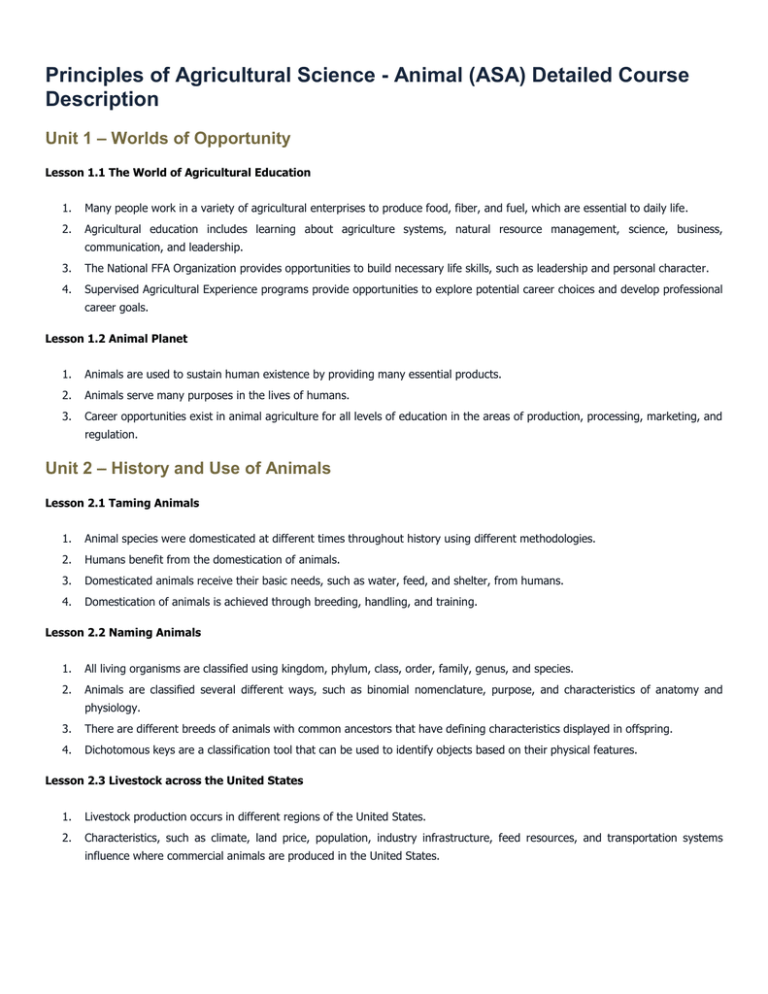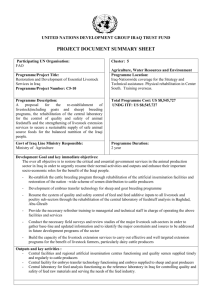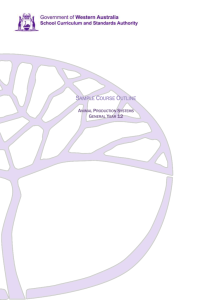Principles of Agricultural Science - Animal (ASA) Detailed Course Description Unit 1
advertisement

Principles of Agricultural Science - Animal (ASA) Detailed Course Description Unit 1 – Worlds of Opportunity Lesson 1.1 The World of Agricultural Education 1. Many people work in a variety of agricultural enterprises to produce food, fiber, and fuel, which are essential to daily life. 2. Agricultural education includes learning about agriculture systems, natural resource management, science, business, communication, and leadership. 3. The National FFA Organization provides opportunities to build necessary life skills, such as leadership and personal character. 4. Supervised Agricultural Experience programs provide opportunities to explore potential career choices and develop professional career goals. Lesson 1.2 Animal Planet 1. Animals are used to sustain human existence by providing many essential products. 2. Animals serve many purposes in the lives of humans. 3. Career opportunities exist in animal agriculture for all levels of education in the areas of production, processing, marketing, and regulation. Unit 2 – History and Use of Animals Lesson 2.1 Taming Animals 1. Animal species were domesticated at different times throughout history using different methodologies. 2. Humans benefit from the domestication of animals. 3. Domesticated animals receive their basic needs, such as water, feed, and shelter, from humans. 4. Domestication of animals is achieved through breeding, handling, and training. Lesson 2.2 Naming Animals 1. All living organisms are classified using kingdom, phylum, class, order, family, genus, and species. 2. Animals are classified several different ways, such as binomial nomenclature, purpose, and characteristics of anatomy and physiology. 3. There are different breeds of animals with common ancestors that have defining characteristics displayed in offspring. 4. Dichotomous keys are a classification tool that can be used to identify objects based on their physical features. Lesson 2.3 Livestock across the United States 1. Livestock production occurs in different regions of the United States. 2. Characteristics, such as climate, land price, population, industry infrastructure, feed resources, and transportation systems influence where commercial animals are produced in the United States. Unit 3 – Animal Handling and Safety Lesson 3.1 Animal Rights or Animal Wrongs? 1. Animal welfare and animal rights are differing belief systems pertaining to the acceptable use of animals. 2. The value humans place on live animals and the use of products derived from animals is influenced by the beliefs of an individual. 3. The use of animals for food and fiber sometimes create ethical dilemmas for producers and consumers. 4. Producers of animal products must consider the welfare of animals during the production process. 5. Profitability is maximized when animals are properly managed. Lesson 3.2 Manipulating Manners 1. Animals respond instinctively to stimuli and changes in their surroundings. 2. Animals exhibit both instinctive and learned behaviors. 3. Safe handling and restraint procedures protect the animal and handler. Lesson 3.3 Home Sweet Home 1. Animals require food, shelter, and water for survival. 2. Animal facilities differ based on environmental factors, species, use, and size of operations. 3. Animal facilities are designed to protect the safety and health of animals and handlers. 4. Animal facilities should include biosecurity precautions. 5. Biosecurity practices are implemented to reduce the spread of pathogens on farms. 6. Safe laboratory procedures include reading and following all instructions, wearing proper personal protective equipment, and cleaning up thoroughly when finished. Unit 4 – Cells and Tissues Lesson 4.1 Units of Life 1. Animal cells share similarities and differences with plant cells. 2. Animal cells are comprised of many parts that have essential functions for the survival of animal tissue, such as respiration. 3. Cell organelles can only be seen using a microscope. 4. There are many different classifications of cells based on their utility. 5. Cells use water, oxygen, and glucose to produce energy and metabolic by-products of carbon dioxide and water. 6. Cells use the processes of osmosis and diffusion for the uptake of water and dissolved nutrients required for metabolism and growth. Lesson 4.2 Putting the Puzzle Together 1. External body parts of animals vary among different species and are important as reference tools for animal selection, health, and management. 2. A collection of organized cells create tissue responsible for various life sustaining functions. 3. The body structure of a vertebrate animal is comprised of a skeleton made of bone and cartilage with ligaments attached to muscle tissue to provide motion. 4. The collection of epithelium, connective, muscle, and nerve tissues in an organ interact to perform specific functions within an animal’s body. 5. Multiple organs work together and form physiological systems. Lesson 4.3 Breathing and Beating 1. The respiratory and circulatory systems are closely related and essential for animal life. 2. External respiration is a process of gas exchanges between the lungs and blood. 3. The circulatory system relies on the heart to pump blood throughout the body. 4. Respiration and heart rates may be affected by external conditions, such as temperature and physical activity. Lesson 4.4 Body Control Centers 1. The information control center of the body, the nervous system uses the central nervous system and the peripheral nervous system to transmit messages. 2. The endocrine system secretes hormones that regulate, stimulate, or inhibit activities within the body. 3. The body’s filtering system, the renal system is designed to remove wastes produced in the cells. 4. Body systems work in harmony to maintain the essential processes needed to sustain life. Unit 5 – Animal Nutrition Lesson 5.1 Digestion Junction 1. Digestive systems vary among species of animals. 2. Ruminants have a four-chambered stomach consisting of the rumen, reticulum, omasum, and abomasum, each with a specific function. 3. Digestion and absorption is accomplished through a process of mechanical, chemical, and biological decomposition of food by the organs of monogastric, ruminant, pseudo-ruminant, and avian digestive systems. 4. Diet of an animal is determined by its type of digestive system. Lesson 5.2 The Need for Feed 1. Animals require nutrients from all six nutrient groups to thrive, survive, and reproduce. 2. The specific nutritional requirements of individual animals are dependent upon species, age, and level of production. Lesson 5.3 Feedstuffs 1. Animals derive nutrition from a variety of sources including roughages and concentrates. 2. Feedstuffs of the same type can vary in nutrient composition and nutritional value. 3. The nutritional value of a feed can be determined through feed analysis. 4. Feed labels are an important source of nutritional information. 5. The nutrient content of feeds varies based on the location, time of harvest, growing conditions, water availability, and soil conditions of the area in which the feed is grown. Lesson 5.4 Nutritional Disorders 1. Animal growth, development, and health are directly related to meeting nutrient requirements of the animal. 2. A deficiency or toxicity of one or more nutrients may result in poor growth and performance. 3. Animals at various stages of growth and development have different nutrient requirements. 4. Nutrient deficiencies in animals may result in poor performance and economic losses. Lesson 5.5 What’s for Dinner? 1. Livestock rations are developed to meet animals’ requirements, maximize feed efficiency, and minimize cost of production. 2. Concentrates and roughages form the bulk of a ration, which can be formulated using a variety of methods. 3. Supplements are used to complete a ration in order to meet an animal’s nutritional requirements. 4. Using mathematics and problem solving are important skills for animal producers when formulating rations. 5. Marketing products is essential to the success of an animal enterprise. Unit 6 – Animal Reproduction Lesson 6.1 Mom, Where Do Calves Come From? 1. Male and female reproductive systems differ in structure and function. 2. The female reproductive system consists of the ovary, infundibulum, fallopian tubes (oviducts), uterus, cervix, vagina, and vulva. 3. The male reproductive system consists of seminiferous tubules, testes, scrotum, epididymis, vas deferens, prostate gland, Cowper’s gland, seminal vesicle, urethra, and penis. Lesson 6.2 Generating Generations 1. Straight breeding is used to produce purebred breeding stock while crossbreeding is used to produce vigorous market animals. 2. There are four breeding methods a livestock producer may choose when breeding livestock, which each have advantages and disadvantages. 3. Artificial insemination and embryo transfer allow producers to improve the genetics of their animals more efficiently. 4. Cloning is possible in livestock, but not practical or widely used at present. 5. The potential fertility and viability of semen may be determined based on its motility, morphology, and concentration. Lesson 6.3 The Pathway to Production 1. Reproductive processes vary by species of animal. 2. The reproductive cycle of females consists of puberty, the estrous cycle, gestation, parturition, and lactation. 3. Understanding of the estrus cycle and hormonal control is essential for reproductive success. 4. The breeding season of animals may be manipulated for economic gain. Unit 7 – Genetics Lesson 7.1 A New Pair of Genes 1. Fertilization of egg cells requires the joining of genetic material in the form of gametes from both male and female parents. 2. Eggs, or ova, undergo meiosis and mitosis for development of new cell tissue. 3. Mitosis has five distinct phases necessary for cell division. 4. Genetic traits, such as coat color, muscling, and horns are passed from one generation to the next by discreet units called genes. 5. Economically relevant traits can be predictably changed through genetic improvement by selective breeding. 6. Dominant and recessive genes determine the phenotypic characteristics of animals. 7. Some animals’ phenotypic characteristics are expressed as sex-links traits. Lesson 7.2 Predicting Genetic Inheritance 1. Genetic inheritance may be from a single gene pair, which is called a qualitative trait or through multiple gene pairs, which is called a quantitative trait. 2. Punnett Squares are used to predict the probability of inheriting qualitative traits. 3. Ratios are used to compare animals within a contemporary group. 4. Quantitative traits are a combination of heritable traits and the environment in which the animals are raised. 5. Expected Progeny Differences are utilized by producers to select animals for heritable traits. 6. Pedigrees contain important information for tracing genetic history. Unit 8 – Animal Health Lesson 8.1 Popular Pathogens 1. Diseases are transmitted in a variety of ways. 2. Infectious disease agents can be spread by vectors and fomites. 3. Infectious diseases are caused by bacteria, viruses, fungi, protozoa, and prions. 4. Animal health management results in limiting disease and maximizing production. Lesson 8.2 Diseased! 1. Signs of good health and poor health are used to identify illnesses. 2. The vital signs of animals vary among species. 3. Diseases are diagnosed through observation of symptoms and physical examinations. Lesson 8.3 Bugged! 1. External parasites live on and in the animals’ skin at the expense of the host. 2. Internal parasites live in the organs of an animal at the expense of the host. 3. Knowledge of the life cycle of parasites can aid in their control. 4. Prevention and control of parasites is important in the production of agricultural, alternative, and companion animals. 5. There are multiple methods to determine the presence of parasite eggs in an animal, of which the laboratory is the most accurate. Lesson 8.4 Pathogens Prevented 1. Disease prevention includes vaccination, sanitation, ventilation, and nutrition and is morally and economically warranted. 2. Vaccines are available for many common diseases. 3. Record keeping is important in scheduling and administering preventative medications. Unit 9 – Animal Products, Marketing, and Selection Lesson 9.1 The Products of Our Toil 1. The primary purpose of livestock production is food and fiber. 2. Grading is used to provide a consistent and palatable product. 3. Products may be categorized as fresh or processed. 4. Consumer demand drives production and availability of fresh and processed goods. Lesson 9.2 In Search of the Ideal Animal 1. Criterion-based selection establishes priorities and provides consistency when evaluating animals. 2. Animal conformation is evaluated using priorities for each species and purpose of animal. 3. Producers use qualitative and quantitative comparison of live animals to predict value in the marketplace. 4. Offspring performance may be predicted and improved by selecting animals based on performance records. Lesson 9.3 Value Added 1. The four elements of marketing are product, price, place, and promotion. 2. Marketing of agricultural products is necessary to move goods from producer to consumer. 3. Brand name recognition, niche marketing, and value-added products increase the value of a good. 4. A solid marketing plan is necessary to increase the value and sales of a product.



